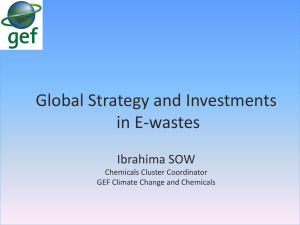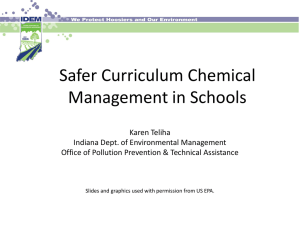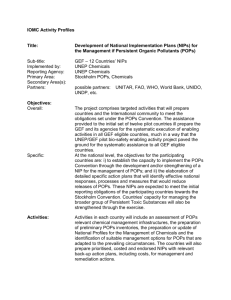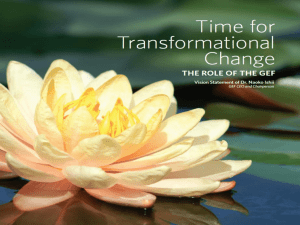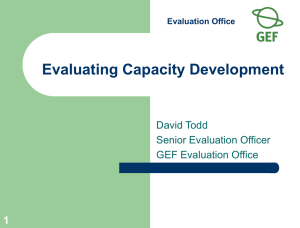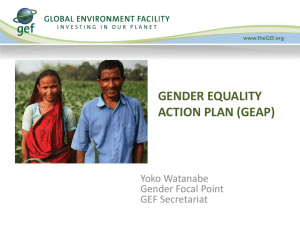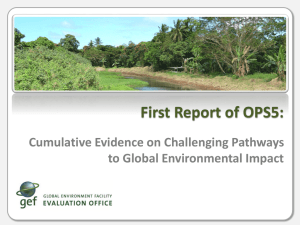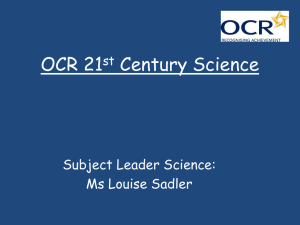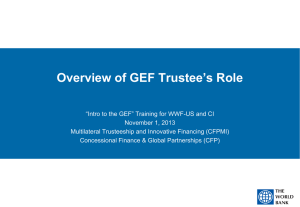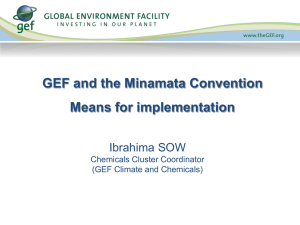Global Environment Facility - Programme Action 6
advertisement
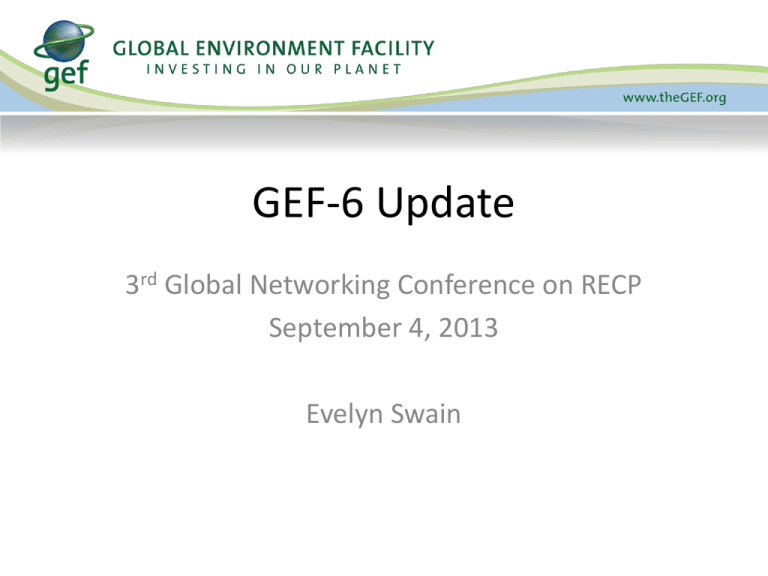
GEF-6 Update 3rd Global Networking Conference on RECP September 4, 2013 Evelyn Swain About the GEF The GEF unites 182 countries in partnership with international institutions, civil society organizations (CSOs), and the private sector to address global environmental issues while supporting national sustainable development initiatives. Today the GEF is the largest public funder of projects to improve the global environment. An independently operating financial organization, the GEF provides grants for projects related to biodiversity, climate change, international waters, land degradation, the ozone layer, and persistent organic pollutants. Since 1991, the GEF has achieved a strong track record with developing countries and countries with economies in transition, providing $11.5 billion in grants and leveraging $57 billion in co-financing for over 3,215 projects in over 165 countries. Through its Small Grants Programme (SGP), the GEF has also made more than 16,030 small grants directly to civil society and community based organizations, totaling $653.2 million. For more information GEF Chemicals ClusterArea of Work The GEF Chemicals Focal Area includes POPs, ODS, Mercury and Sound Chemical Management for increased coherence. Phase out of Persistent Organic Pollutants – Stockholm Convention Phase out of Ozone Depleting Substance, specifically to Countries with Economies in Transition – Montreal Protocol Pilot activities and enabling conditions on mercury – to support early ratification of Future Minamata Convention on Mercury Pilot activities on chemicals (and chemical issues) of Global Concern – Related to the Objectives of the Strategic Approach to International Chemicals Management (SAICM), including E-waste, chemicals in products and lead in paint. Overview of GEF Investments on POPs Since 2001 the GEF has committed US$ 695 million to projects in the Chemicals focal area and leveraged some US$ 1.701 billion in co-financing from partners in the public and private sectors, bringing the total value of the GEF POPs portfolio to over US$2.4 billion. To date, the GEF has financed NIPs development projects for all developing countries Parties requiring support. So far 108 Parties have already submitted their NIPs to the Secretariat of the Stockholm Convention. The GEF also financed 109 post-NIP projects for the implementation of the Convention. GEF-5 Funding for Chemicals • $425 million allocated to chemicals. The distribution of resources is as follows: • POPs: $375 million • Ozone: $25 million • Sound chemicals management and mercury reduction: $20 million (an additional $10 M was approved for mercury at the June GEF Council Meeting) GEF-5 Projects • In GEF-5 projects were approved to support resource efficiency and clean production. • Examples: – Eco Industrial Park for Sustainable Industrial Zone in Vietnam (UNIDO, $3.5 M) – Mercury in Products in Uruguay (UNDP, $770,000) – Global Chemicals in Products (pending UNEP, ~$1 M) GEF-6 Planning: Chemicals and Waste Strategy • An integrated Chemicals and Waste Focal Area is planned for GEF-6 • Including Stockholm Convention, Montreal Protocol, future Minamata Convention on Mercury and SAICM issues • Green Chemistry will be a component of GEF-6strategy under development- resource efficient and clean production will be a key component • Second replenishment meeting in India next week New POPs in GEF-6 • Addressing New POPs will also be a focus of GEF-6 requiring clean production practices and life cycle management. • Example: – Brominated flame retardants in products, everything from textiles, to electronics, to building materials. GEF 6 Chemical and Waste Framework Goal: A significant reduction in the exposure of humans and the environment to hazardous chemicals and waste of global importance Objectives Programs CW 1: Promote the development of the enabling conditions, tools and environment to manage harmful chemicals and wastes Program 1: Develop and demonstrate technologies, techniques, policy and legislation for eliminating and reducing harmful chemicals and waste Program 2: Promote innovative and sustainable financing, business models and economic approaches and solutions for eliminating harmful chemicals and waste Program 3: Support conventions reporting and national plans and promote their integration into national planning processes and actions Program 4: Support global monitoring, development of registries, inventories and data collection CW 2: Reduce the prevalence of harmful chemicals and waste Program 5: Facilitate the deployment of environmentally safe technologies, techniques, practices and approaches for the elimination and reduction of harmful chemicals and waste Program 6: Deploy alternatives and alternative techniques and practices for reducing harmful chemicals Program 7: Complete the phase out of ODS in CEITs and assist Article 5 countries under the Montreal Protocol to achieve climate mitigation benefits CW 3: Support LDCs and SIDS to take action on harmful chemicals and waste Program 8: Support regional approaches to eliminate and reduce harmful chemicals and waste THANK YOU Evelyn Swain eswain@thegef.org
